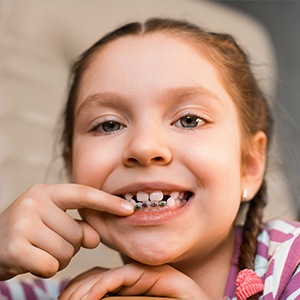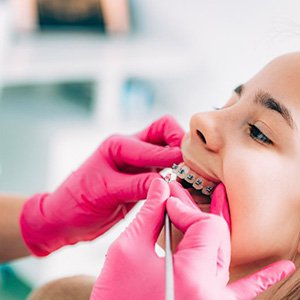
Phase 1 Pediatric Orthodontics – Enfield
Giving Young Smiles a Strong Start

As a parent, you want to give your child the best possible chance to succeed at just about everything. At Cordes Orthodontics, we’re more than ready to help by providing early-age orthodontic care that can correct alignment issues with the baby teeth as well as prevent ones from developing in permanent teeth. Dr. Cordes typically recommends that a child should receive a free, full orthodontic evaluation around age 7. That doesn’t necessarily mean your child will start orthodontic treatment at age 7. However, it allows Dr. Cordes to identify a problem and follow it for the right time to start treatment. In fact, most of our pediatric patients start treatment around the ages of 11-12. By acting early using phase one pediatric orthodontics in Enfield, CT, he can help your child achieve their best smile as soon as possible.
Why Choose Cordes Orthodontics for Phase 1 Pediatric Orthodontics?
- Father of 3 with More than 20 Years of Experience
- Fun, Friendly & Laid-Back Orthodontic Office
- Latest Technology Makes Appointments Quick & Easy
How Phase 1 Orthodontics Works

Phase I Orthodontics is used to accomplish 3 specific goals: correct alignment issues in the baby teeth, make sure the adult teeth have a clear path to come in straight and stop any habits that might inhibit proper oral development (like thumb sucking or tongue thrusting).
When you bring your child to see Dr. Cordes, he’ll give them a brief exam. If he sees orthodontic problems and/or the signs that others will develop as they grow, he’ll recommend Phase I Orthodontics. This approach typically takes about a year, and it should set the stage for your child’s adult teeth to erupt correctly.
Who Is a Good Candidate for Phase 1 Orthodontics?

Not all children need interceptive orthodontics, but some significantly benefit from it. That’s what makes their consultation so important. Phase 1 orthodontics are typically recommended for children who have:
- Difficulty chewing
- Trouble speaking clearly
- Overcrowded teeth
- Spaced-out teeth
- Protruding teeth
- A disproportionate jaw
The Benefits of Phase 1 Orthodontics

There is a wide range of benefits that children can experience with pediatric orthodontics. Here are some of the prominent ones:
- Shorter Treatment Time: When a child undergoes phase 1 orthodontics, they usually require less orthodontic care in the long run. This helps parents and patients to save time and money.
- Improved Confidence: Straightening the teeth can help children feel more confident when showing off their smiles. This can make a huge difference in their mental health as they grow up.
- Easier Function: Aligning the teeth early helps to promote proper development. This will help your child to eat, speak, and smile comfortably.
What Happens During Phase II?

At the end of Phase I, your child’s mouth will be given some time to rest and adjust, and then, once most of the baby teeth have fallen out, Dr. Cordes will give them another exam. Once more of their permanent teeth have come in, if there are any misalignments, he will recommend they get braces. Thanks to the work done during Phase I, a child will likely have to spend much less time in braces. Plus, many issues may have been already corrected or avoided altogether, helping a child achieve their ideal smile as quickly and easily as possible.
Phase 1 Orthodontics FAQs

Want to ensure that your child has the best chance of having a straight smile in the future? If so, then Phase 1 orthodontics may be the solution you’re looking for. While this process may be beneficial for your little one in the long run, it’s natural to want to know everything you can about the treatment before committing it. To help you feel more confident and well-informed about this option, our team has compiled and answered some of the most frequently asked questions about Phase 1 orthodontics from our patients. Read on or give us a call today to learn more about this treatment plan!
When Does Phase 1 Orthodontics Take Place?
Also known as “interceptive orthodontics,” Phase 1 orthodontic treatments are usually reserved for children ages 6 through 9. This age range is the dentition phase where most people start losing their baby teeth. This is perhaps the best time to implement Phase 1 orthodontics, as Dr. Cordes can swiftly detect issues in tooth development or jawbone growth, which can be easily treated in the younger years. Furthermore, a child’s first molars tend to erupt around 7 years of age, forming the back of their bite and providing our team with an idea of how their smile will shape later on.
What Appliances Are Used in Phase 1 Orthodontics?
Since Phase 1 orthodontics isn’t too complex like other phases, the appliances used for it are much simpler. Children who have overcrowded teeth may be provided with a palate expander, which is a device that helps to make the upper jaw wider. Kids that lose a baby tooth too soon might require a space maintainer to ensure the gap left behind remains while the permanent one grows out. If your little one has severe orthodontic issues, they may need limited braces, which will only be meant for specific pearly whites since their jaw and other teeth are still developing. Our team can walk you through your child’s treatment plan and the kind of appliance(s) they’ll need to set them up for a comfortable and healthy bite.
Is Phase 1 Orthodontics Painful?
Dr. Cordes will do everything he can to ensure the procedure runs smoothly, so your little one shouldn’t feel pain when receiving their appliance. That said, it’s natural for children to feel mild discomfort after getting their appliance placed. The good news is that these sensations are temporary and can easily be managed with over-the-counter pain relievers and cold compresses. Your child’s mouth will also typically adjust quickly to the treatment process. In fact, without Phase 1 orthodontics, your little one could end up experiencing more pain in the future, as bite misalignment can lead to discomfort while chewing.
Does Phase 1 Orthodontics Affect Diet & Nutrition?
Phase 1 orthodontics can influence the kinds of foods your child can eat depending on the type of appliance they receive. If they require a palate expander or even a set of braces, then they may have to avoid foods that are tough to chew, such as nuts, steak, and raw veggies. To prevent causing any damage to the appliance or interfering with their treatment process, they should keep a soft food diet. Their meals should include bread, soft meats, cooked vegetables, and dairy products. However, if your little one has a removable kind of appliance, then they should be free to eat their favorite foods as usual!